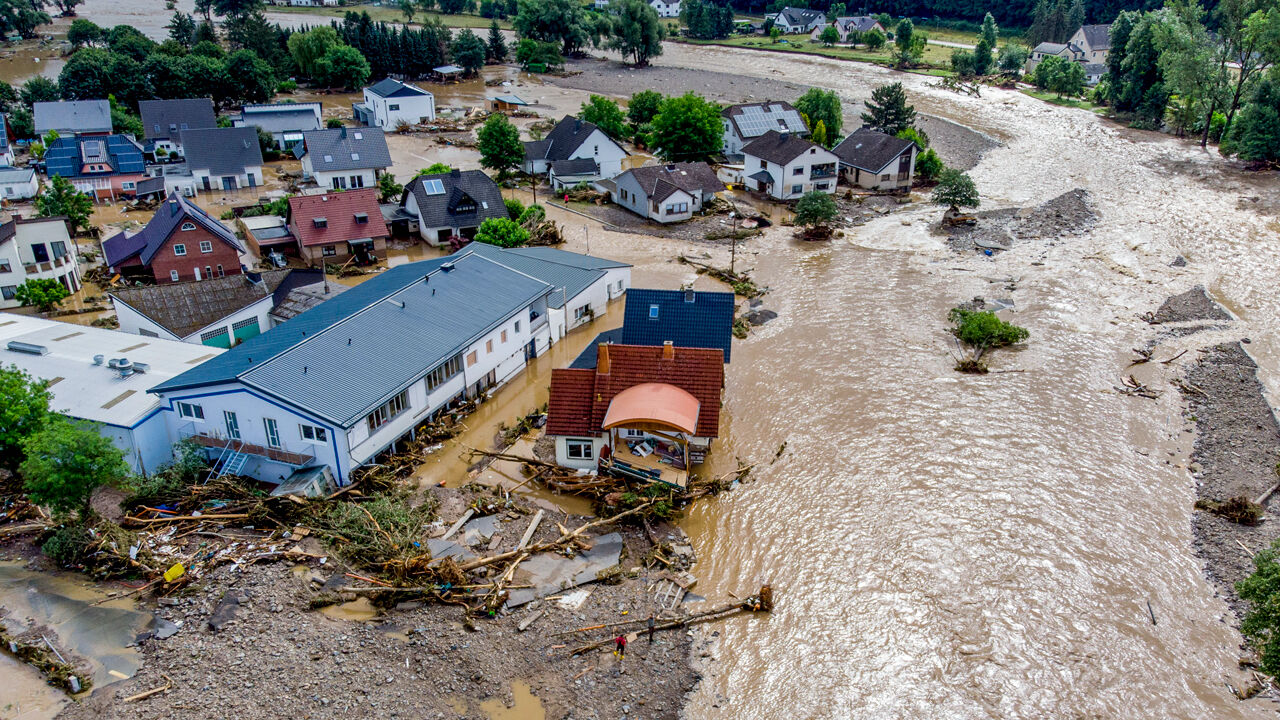
Four days before deadly floods swept through western Germany and parts of Belgium last week, Hannah Cloke saw a forecast of extreme rain on a Europe-wide flood alert system to which she belongs. Researchers “were stupidly congratulating ourselves that we were forecasting something so early. … The assumption was that would be really helpful,” says the hydrologist and flood forecaster at the University of Reading. Instead, she was stunned to see scenes of devastation and death despite the ample warnings. “We should not be seeing this number of people dying in 2021 from floods. It just should not be happening.”
As the magnitude of the destruction becomes clear, European scientists are wrestling with how such damage could happen in some of the world’s wealthiest and most technologically advanced countries, despite major investments in flood forecasting and preparation catalyzed by previous inundations. And they are examining whether climate change helped fuel the disaster—and what that might mean for the future.
Beginning on 13 July, intense storms dropped as much as 15 centimeters of rain in 24 hours, swelling streams that then washed away houses and cars and triggered massive landslides. At least 196 people had died as of 20 July—165 in Germany and 31 in Belgium—and the number is expected to rise. On 18 July, German Chancellor Angela Merkel visited the stricken town of Adenau. The scene was “terrifying,” she said. “The German language can barely describe the devastation.” That same day more flash floods struck Bavaria, in southern Germany.
Researchers are just beginning to unravel the complex web of climatic, hydrological, and social factors that contributed to the catastrophe. But they already have some suspects in mind, including a warming climate that can supercharge rainstorms and European disaster plans that focused on major rivers, rather than the lower volume tributaries hit hardest by the storms.
“We’ve been concentrating a lot on the big rivers,” says William Veerbeek, an urban flood management expert at the IHE Delft Institute for Water Education. “There’s still a lot more to do in the smaller streams.”
For years, scientists have warned climate change will mean more flooding in Europe and elsewhere. Warmer air holds more moisture, which can translate into heavier rainfall. By 2100, flood damage on the continent could cost as much as €48 billion per year—up from €7.8 billion now—if nothing more is done to prepare, and the number of people affected could more than double to some 350,000, according to the European Commission’s Joint Research Centre.
Some European rivers are already exhibiting climate-related changes, says Fred Hattermann, a hydrologist and flood expert at the Potsdam Institute for Climate Impact Research. Along the Danube River, for example, floods that once came every 50 years now happen roughly twice as often, according to recent unpublished work the institute conducted with the German insurance industry.
New research suggests such risks could grow if climate change slows the jet stream—the high-altitude winds circling the Northern Hemisphere—causing drenching rainstorms to linger longer over flood-prone landscapes. Storms that stall over Europe were once exceedingly rare. But according to a study published last month in Geophysical Research Letters, in a worst case scenario such storms could become as much as 14 times more common in 2100 than they were at the start of this century.
The exact weather pattern driving the current storm is different, says the paper’s lead author, hydroclimatologist Hayley Fowler of Newcastle University. But the overall dynamic is similar, she adds: A slow-moving storm overwhelms a region’s river system.
Floods already rank as the most destructive natural hazard in Northern Europe. Past events—including deadly floods in 2002—led the European Commission to launch the European Flood Awareness System, meant to provide emergency managers with early warnings. But last week the speed and intensity of the flooding in Germany—especially in towns perched next to smaller creeks—took most people by surprise. “There was simply no time,” Hattermann says. “Then, of course, people run to save their cars and whatever and bad things happen.”
In the Netherlands, decades of preparation appear to have helped. Even though the Meuse River, which runs through eastern Belgium and into the Netherlands, broke a high flow record set in 1993, it caused far less damage. A tributary of the Meuse flooded the city center of Valkenburg in the south, but no deaths were reported.
Dutch policies aimed at making “room for the river” have widened and deepened river channels, and set aside land where floodwaters can spread out. Those measures were projected to reduce flood peaks on the Meuse by as much as 1 meter, says Nathalie Asselman, a flood management expert and adviser to the Dutch government at Deltares, a research institute. Those predictions appear to be coming true. “When we look at how bad the flooding is, it’s much less than what happened in the ’90s,” she says.
Some researchers are examining how people responded to flood warnings. After the 2002 floods in eastern Germany, Bruno Merz, a hydrologist and civil engineer at the Helmholtz Centre Potsdam of the German Research Centre for Geosciences, surveyed residents. One-third of the people who received flood warnings reported having “no clue” what to do next. Now, Merz wants to know whether such confusion contributed to the current death toll. “All the data shows … that when people get a warning and they take [it] seriously, they can rescue themselves,” he says. “They need 1 hour, not more.”
Merz also has some immediate and personal concerns about the floods. Last week, he learned that a swollen creek had swamped the ground floor of a vacation cottage—named “Brook view”—that his family had rented in a German village. The trip is still on; the landlord pleaded with Merz not to cancel because he needs the money. But, “If there are any problems,” Merz says, “we will just make a detour.”